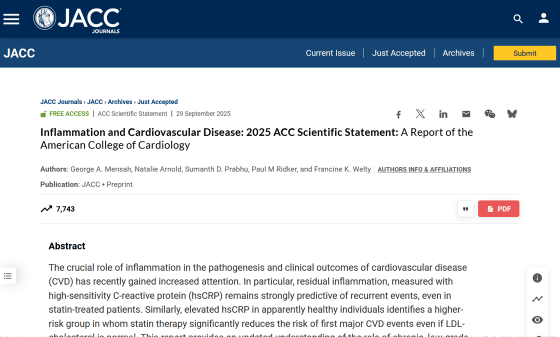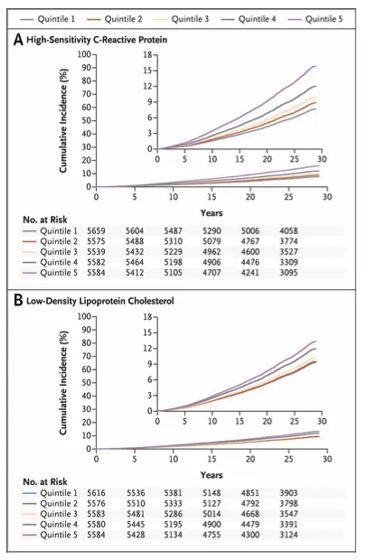Why is inflammation a stronger predictor of heart disease than cholesterol?

In a statement released in September 2025, the American College of Cardiology (ACC) recommended universal screening for inflammation, citing its strong predictors of heart disease. Brandon Ballinger, developer of
Inflammation and Cardiovascular Disease: 2025 ACC Scientific Statement: A Report of the American College of Cardiology | JACC
https://www.jacc.org/doi/10.1016/j.jacc.2025.08.047

Inflammation now predicts heart disease more strongly than cholesterol | Empirical Health
https://www.empirical.health/blog/inflammation-and-heart-health/
It has long been known that chronic inflammation increases the risk of heart disease, but until now inflammation has not been a 'standard heart disease risk factor (SMuRFs).' However, in a statement released in September, the American College of Cardiology announced that high-sensitivity C-reactive protein (hs-CRP) , a biomarker of inflammation, is a strong predictor of heart disease, and recommended that everyone measure hsCRP.
The American College of Cardiology states, 'Clinicians cannot treat what they cannot measure. Therefore, universal screening for hs-CRP in primary and secondary prevention patients is recommended as it represents an important clinical opportunity when combined with cholesterol testing.'

Ballinger points out that the reason the American College of Cardiology has come to recommend measuring inflammatory biomarkers is that 'measurement of inflammation using hs-CRP is a stronger predictor of heart disease than
For decades, LDL cholesterol has been the primary predictor of cardiovascular risk, but recent evidence suggests that hs-CRP may actually be a better predictor of heart disease.
The graph below shows the relationship between hs-CRP levels and heart disease incidence (top), and LDL cholesterol levels and heart disease incidence (bottom). The horizontal axis represents the number of years since measurement, while the vertical axis represents the heart disease incidence rate. The subjects were divided into five groups based on their respective values. The bottom 20% with the worst values are 'Quintile 5 (purple),' the next 20% with the worst values are 'Quintile 4 (black),' the next 20% with the worst values are 'Quintile 3 (yellow),' the next 20% with the worst values are 'Quintile 2 (red),' and the top 20% with the best values are 'Quintile 1 (blue).' All values function as predictors of heart disease. However, when comparing hs-CRP and LDL cholesterol levels, hs-CRP is found to be more accurate in predicting future heart disease incidence.

'In a sense, cholesterol has become a victim of its own success,' Ballinger said. The data, which analyzed the relationship between biomarkers and heart disease, also included people who had previously been found to have high cholesterol and were taking
As a result, even if statins have lowered cholesterol levels at the time of the most recent test, if other risks for heart disease remain, cases may occur in which a person develops heart disease despite having low cholesterol levels.
On the other hand, inflammation is one of the biomarkers not included in SMuRFs that is most closely associated with heart disease risk, so even if cholesterol levels are lowered by taking statins, high hs-CRP can predict a high risk of heart disease.

Related Posts:
in Science, Posted by log1h_ik







